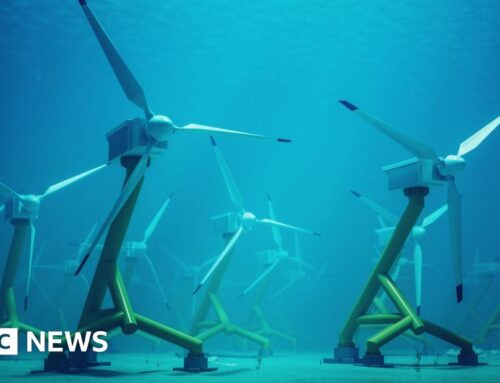Data Centers: Economic benefit or environmental boondoggle?
April 15, 2025
This story originally appeared in the Sierra Nevada Ally and is being republished here as part of a content-sharing agreement. Read the original version here.
Last month, the Reno City Council approved the Oppidan Data Center to become the city’s second data center, despite the city planning commission’s original denial of the project. The back-and-forth decision coincides with the ongoing city council debate about how to regulate data centers, in light of their significant energy and water demands to power artificial intelligence (AI) models such as ChatGPT.
“Every time a user inputs a prompt, ChatGPT’s massive language model processes it using an estimated 2.9 watt-hours (Wh) of energy,” reported RW Digital, a digital marketing firm. “That’s nearly ten times what it takes for a single Google search.”
A Google search uses the equivalent energy needed to power a standard lightbulb for almost 20 seconds, but that’s a modest amount compared to a ChatGPT inquiry. ChatGPT sees more than 200 million queries daily, consuming about 621.4 megawatt-hours (MWh) of energy. This energy demand is sufficient to power an average American home for more than 57 years.
Therefore, using artificial intelligence models now beckons the question: How am I planning to compensate for the climate toll of AI?

“Becoming overly reliant on AI and other power-hungry processing tools has a significant impact on our ability to move away from greenhouse gases,” said Sierra Club Toiyabe Chapter Director Oliva Tanager. “AI seems cool, but really it’s siphoning money in more ways than one from working class people to the billionaire class.”
The Sierra Club has found utility rates have gone up for residents in states that have experienced a data center rush. Because of this, one California planning commissioner has dubbed data centers “tapeworms” that take from the community and fail to give back in a meaningful way.
“Utility customers should not have to pay the price when a big data center sets up shop in their area,” said Abe Scarr, the state director with Illinois PIRG Education Fund. “Maximizing energy efficiency, generating clean power on-site and ensuring that data centers pay the full cost of necessary grid upgrades can help reduce the impact on consumers.”
That’s in part why Tanager and the Sierra Club are working to pause local data center development so regulations can be defined, citing negative economic and energy impacts elsewhere.
“We are asking for a pause in the development of data centers,” said Tanager. “So that decision-makers at every level and community members across Northern Nevada can get a handle on how these facilities impact residents, climate goals and natural resources.”
While many electric grids rely on fossil fuels, data centers also place additional strain on energy systems that are actively transitioning toward renewable sources. This means data centers are inadvertently delaying the drawdown of greenhouse gas emissions.
According to the Electric Power Research Institute (EPRI), Nevada, along with 14 other states, account for 80 percent of the nation’s electrical demand for data centers. Specifically, the EPRI found that data centers accounted for 8.69 percent of all the electricity consumed in Nevada in 2023, and the organization projects that figure could grow to nearly 20 percent by 2030.
The same EPRI report projects that the electricity demand of data centers could potentially reach 166 percent of current levels within the next five years.
“The United States accounts for by far the largest share of this projected increase,” a separate report from the International Energy Agency stated. “By the end of the decade, the country is set to consume more electricity for data centres than for the production of aluminum, steel, cement, chemicals and all other energy-intensive goods combined.”
So how will this growing demand affect utility rates for Nevadans? The Sierra Nevada Ally reached out to NV Energy and received the following email response:
“We coordinate closely with all new businesses looking to come to Nevada, including data centers. Our teams work diligently on our long-term planning to make investments in our infrastructure to serve new customers and the continued growth in the state without putting existing customers at risk. NV Energy currently serves approximately 25 data centers in the state.”
NV Energy did not respond to repeated follow up inquiries.
Much like people in the hot summer sun, data centers also require significant water demands for cooling. One large data center is capable of consuming upwards of 5 million gallons of water a day – equivalent to seven and a half Olympic-sized swimming pools. According to a presentation at the February Reno City Council Meeting, the local data centers will use less than 10 acre/feet of water each year, or about five Olympic-sized swimming pools.
In the most arid state in the country, wise water use is paramount. This hydro-demand could add resource-stress to the local community.
“One-fifth of data center servers’ direct water footprint comes from moderately to highly stressed watersheds, while nearly half of servers are fully or partially powered by power plants located within water-stressed regions,” wrote researchers Abu Bakar Siddik, Arman Shehabi and Landon Marston in a key study about data center resource consumption.
Locally, the Truckee Meadows Water Authority (TMWA) is taking steps to protect the region’s water resources.
“The requirement for [data center] water service is the same as with any new development,” said Danny Rotter, TMWA’s assistant general manager. “Developers must obtain water rights on the open market and dedicate them to TMWA.”
For every acre-foot required for service, TMWA requires developers to add an additional 11 percent of water rights for drought reserves. This water is stored in upstream reservoirs, such as Boca or Stampede. This safety net is matched by TMWA’s population prediction modeling conducted every five years, which helps predict future water demand.
“Using the most advanced population forecasting and water supply modeling available, TMWA’s Water Resource Plan indicates our region will have sufficient resources for decades to come,” said Rotter.
Though new projects such as data centers may require additional infrastructure, “developers are assessed hook-up fees and required to pay for any new infrastructure needed for their projects,” said Rotter. “From pipes to pumps to increased treatment capacity.”
This requirement places the cost of new development in the hands of the developer, not existing customers, which is a TMWA policy.
Data centers in Nevada are eligible for a 75 percent property tax abatement, along with other tax incentives. In theory, tax abatements spur economic growth by enabling businesses to pay discounted taxes to the state for a designated period of time. While tax abatements are often leveraged to bring new employment to the region, they can come at a cost to local resources. These tax breaks often divert funds away from things like funding for affordable housing, health care services, park maintenance, and other essential public services.
Furthermore, data centers typically do not generate substantial long-term local employment. Once operational, a data center generally employs between five and 30 highly skilled individuals, with most of the new jobs coming from construction.
Despite these economic implications, solutions exist for effectively regulating and building data centers.
Tanager points to the city of Missoula, Montana as an example of future-proof thinking around data center regulations. For one, the city requires data centers to offset electricity use with renewable energy production. She recommended Reno capitalize on these lessons to avoid harm to the local community.
“[They have] restricted data centers to industrial areas, requiring verification that all electronic waste be handled by a licensed recycling firm,” said Tanager.

For Tanager and the Sierra Club, they believe the public should care about new data centers because of how hugely harmful they can be to local communities.
“What this really boils down to is a class issue: Working class people do not want their neighborhoods filled with noisy, hot data centers that don’t employ any of their neighbors,” said Tanager.
“Key players in Nevada are dragging their feet because they have convinced themselves that turning Northern Nevada into the next Silicon Valley is a good idea.”
Search
RECENT PRESS RELEASES
Related Post



